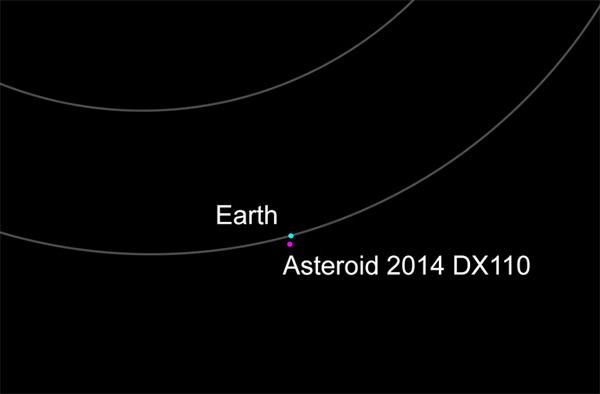Dinky Space Rock to Buzz Earth in Not-So-Scary Flyby
NASA, you're not helping: Asteroid 2014 DX110 isn't really the same size as Earth, the dots are just there to show the close proximity the small space rock will come to Earth -- dots not to scale! (Diagram from NASA news release)
It happens 20 times a year, but the mere mention of an asteroid flying past Earth is enough to whip the tabloid press into a frenzy.
Today, at 4:07 p.m. EST, asteroid 2014 DX110 will zoom past our planet at a safe distance of 217,000 miles (350,000 kilometers). This is a pretty cool nugget of science news as the asteroid, which was discovered on Feb. 28 by the Pan-STARRS project in Hawaii, will careen past Earth closer than moon orbit. Telescopes are primed and the asteroid will be closely observed to find out its mass, composition and orbital characteristics.
Although this is certainly a “near miss” on cosmic scales (and the largest space rock to come so close to our planet since asteroid 2013 PJ10 flew past last August), this particular rock is neither “huge” or scary, on a global scale at least. It’s approximately 100 feet (30 meters) wide, only a little bigger than the meteoroid that slammed into the atmosphere over Chelyabinsk, Russia, in February 2013.
Granted, depending on its composition, if 2014 DX110 did hit Earth (which it won’t), it could generate a powerful airburst or even survive fiery atmospheric entry and the surviving rock hit the ground as a small meteorite. This would be a bad day for anyone in the meteorite’s path, but Earth is big and it’s more likely the space rock would impact over an unpopulated landmass or the ocean.
This event, that is being tracked by the Slooh telescope and broadcast live (programming begins at 4pm EST), is a testament to the sophistication of asteroid-tracking surveys that are capable of detecting smaller and smaller asteroids as they stray into our interplanetary neighborhood.
Pan-STARRS is part of the Near-Earth Object Observations Program (known as “Spaceguard”) and is critical for our ability to detect, track and characterize the huge population of near-Earth objects that could threaten Earth.
Although keeping tabs on rocks like 2014 DX110 is important — after all, knowing where and when a Chelyabinsk-scale event is going to happen would be key to minimizing danger on the ground and these are the class of asteroids that are small and most likely to go unnoticed — Spaceguard is more interested in detecting and tracking the orbits of bigger lumps of asteroid that could disrupt life on our planet. So when reading the tabloids, take note that their definition of “huge” probably isn’t the same as what astronomers characterize as “huge.”
Some comparisons:
•1 Ceres: The largest asteroid in the solar system. It’s so large it even has a minor planet designation making it a dwarf planet. Size: 590 miles (diameter) — huge..
•4 Vesta: Another chunky asteroid with protoplanetary aspirations that lives in the asteroid belt. Size: 326 miles — huge.
•99942 Apophis: A near-Earth asteroid that caused a flurry of concern in 2006 when it was discovered. After further analysis of the asteroid, a 2036 impact was ruled out and we can all breathe easy again. If an asteroid the size of Apophis did hit, devastation over a region thousands of miles wide would result. Size: 325 meters — pretty meaty.
•Tunguska: On the lower end of “huge,” the object that exploded over Tunguska, Russia, in 1908 flattened a forest in an unpopulated region. Size: Up to 70 meters — small-ish.
•2014 DX110: Size: 30 meters — a space pebble.
Source: NASA/JPL
h/t: Thanks to Steve P. Knight for pointing out the Mirror.co.uk‘s definition of “huge” might be a little generous for asteroid 2014 DX110.(Mar 5, 2014 02:18 PM ET // by Ian O'Neill)












